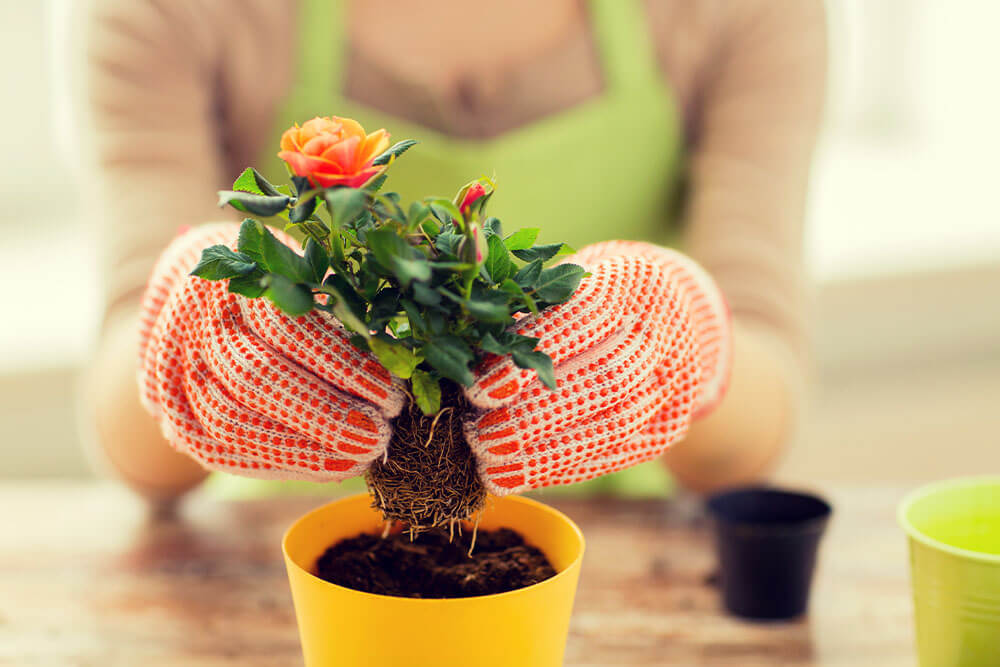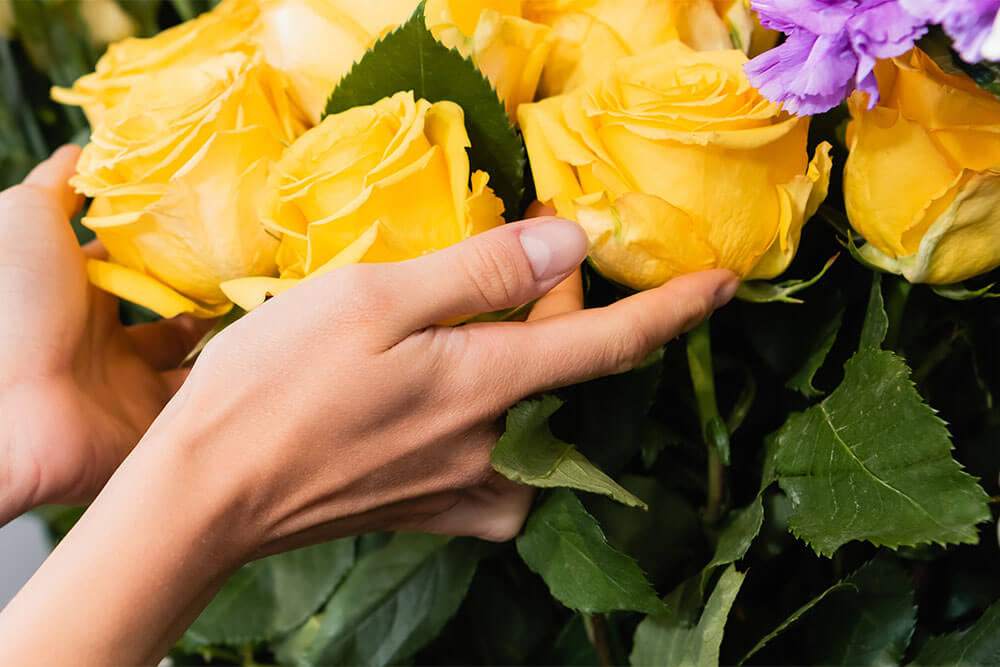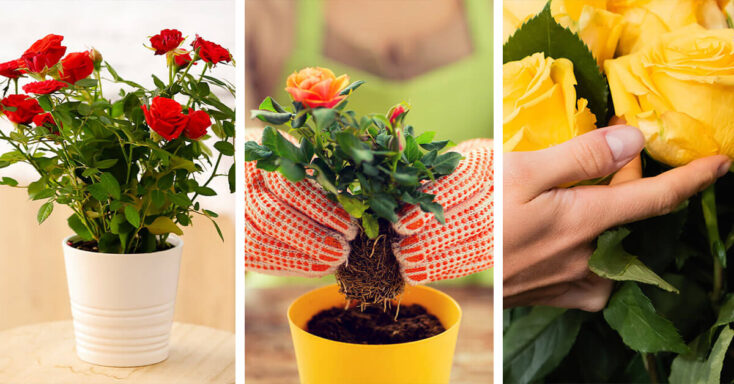Looking out the window and seeing roses brings a smile to your face. Or, perhaps, you walk by a strand on your street. The scent is magically alluring. Did you know you can grow and care for roses indoors? You can have pretty blossoms year-round, and they are easy to keep healthy.
Rejoicing in Roses
Roses, particularly miniature ones, make a lovely addition to your indoor gardening efforts. Find a sunny south-facing window where they can receive 6 hours of light daily, and your roses will thrive. When you don’t have a good window choice, you can use grow lights for 14 hours a day.
Provide a 5-5-10 fertilizer (roses need a lot of potassium) once a month. If the temperature of your house is around 70 F (give or take ten degrees), it’s perfect. Your miniature plant produces petite blossoms. Despite their size, they’re hardy and often bloom repeatedly.
A little bit of history: In Roman Mythology, Cupid gave a rose to Harpocrates (the God of Silence) so he could never reveal Venus’ secret. Going forward, specific areas like meeting halls had rose carvings as a reminder that no one other than those present should be privy to the information exchanged. Rose images appeared on confessionals, stressing the trust in the pastor as a person exchanged privileged information.
Tip: if you have proper lighting, bring your miniature rose to eye level where you and your guests can truly appreciate their beauty.
Roses are Out of This World: A rose named Overnight Scentsation (pun intended) went into orbit on October 29, 1998. It traveled on STS Discovery Mission and had the distinction of being the first rose in space.
Key Takeaways
- Miniature Roses are an ideal selection for your indoor garden.
- Indoor roses are a little fussy, so they’re not the best choice for beginner gardeners.
- For best-growing results, indoor roses need 6 hours a day of sunlight. Some rosarians choose to use grow lights for this purpose.
- You can put your indoor potted roses on display outdoors in warm months in places like a deck.
9 Anecdotes about Growing Roses Indoors
Roses in Antiquity: Archaeologists have uncovered rose fossils dating back 35 million years. In the Guinness Book of Wild Records, roses were the first species used for decoration, supported by documents from 50 AD. The writings said Romans grew vast groves of rose, not just for beauty but as medicine extracts.
There is a rose in Germany that is documented as being 1,000 years old (yes, really).
Choosing the Right Rose
People who focus their gardening efforts on roses are called rosarians. Any rosarian will tell you that the variety of miniature roses can feel daunting. As you shop, keep your indoor space in mind. For example, if you have limited space, seek a climbing species like Alchymist or Fourth of July. Remember, the term climbing is somewhat askew. These roses have long canes. You connect them with a trellis, effectively training them.
Here are some cultivars specifically developed to thrive in part shade, making them suited to indoor living.
Cecile Brunner: an example of a climbing tea rose. There doesn’t seem to be a place where they don’t fit. Cecil Brunner has a delicate aroma and feels “cherry” with its deep pink interior and double soft pink petals.
Celestial Night: This rose aims to please with continuous blooming. You will have to prune and deadhead to achieve a glorious display. The fragrance is enticing. The flowers? Plum!
Golden Celebration: This rose is an over-achiever producing up to 75 flowers per cycle. Its amber petals are simply stunning. Golden Celebration also produces a pleasant fragrance.
Marie Pavie: Sometimes considered the queen of miniature roses. This flower is all about romance, flaunting soft-pink flowers. Marie Pavie grows throughout the season. She has a very subtle, pleasing aroma.
Peach Drift: A plucky little rose growing to a height of only 18 inches. It gets its name from the peachy smell emitted from double blooms and coral flowers against dark green foliage.
Peter Pan: If you love diminutive roses, this one’s for you. The yellow stamens show off against intense crimson petals. Peter Pan wants about 8 hours of sunlight for the best blossom.
Perle D’Or: An elegant and sophisticated apricot rose. The hue of this plant is darker in the center of the blossom, then gently fading to pastel. It has no unusual needs for an indoor rose.
Rainbow Sunblaze: This bright yellow flower has an orangish margin on the outer petals. The plant has a thick leaf background. This is one choice that has lower maintenance, making it a potential plant for inexperienced gardeners.
Veteran’s Honor: The Veteran’s Honor comes under the category of a tea rose. The double blooms are blazing red and smell a bit like raspberries. It takes to potted life well.
Roses develop a berry referred to as rose hips. The color of the berries varies from orange and red to dark purple. These ½” fruits have a high level of Vitamin C. Use them in tea, for canning jam, or to make syrup.
When to Plant Rose
In a nursery setting, roses are dormant in January and February. This is the best time for potting. Look for a planter with excellent drainage and a bottom diameter that’s as wide as the flower’s canopy. Use peat soil to ensure better drainage.
A Smell so Sweet: Rose oil is an important ingredient in perfume. It takes 2,000 roses to produce one gram of oil, thus the high prices. Damask roses are a preferred choice for making oil. People gather the blossoms at night when their oils are strongest.
How to Plant Rose
When removing the rose from its container, take care. You don’t want to disturb the soil ball. Put your rose into a porous loam containing peat, perlite, and vermiculite. When buying a commercial blend, look for 14-14-14. It feeds the soil for lively root growth.
Before you buy a pot, look at the size of your plant’s canopy. You want a container whose bottom size matches the diameter. Also, make sure the drainage system is excellent. Miniature roses can drown in too much water.
Abundant Roses: Ecuador is among the top suppliers of roses in the world. The climate is perfect for the rose to thrive. This country has dedicated 54% of its land in Ecuador to growing this flower.

Keeping Your Roses Radiant
Every plant has certain parameters you can follow. Growing roses indoors is no different.
- Darkness: “Daylight requirements” for plants comes up in every article. Darkness, however, gets overlooked. When the roses are out of the light, the plant utilizes all that yummy food manufactured by day. 8 hours is good.
- Light: Your indoor roses need proper light to produce quality blossoms. Keep them as close as possible to natural lighting. In the absence of that, use lamps.
- Humidity: Roses will appreciate a humidifier. Your home probably averages 20%, whereas this plant craves 50%. Mist them twice a day.
- Temperature: By night, roses enjoy temperatures hovering around 60 F. By day, 70 F is best. Warmth actually helps your rose to manufacture food.
- Ventilation: Fungal disease develops where there is not enough air circulation. A small fan is an easy fix.
- Water: Every other day, water your plant. But wait! Place your finger in the soil. Is it still wet? If so, hold off.
England’s national flower is the rose. In America, state flowers include:
- DC: American Beauty
- Georgia: Cherokee Rose
- Iowa: Wild Rose
- New York: Rose
- Oklahoma: Oklahoma Rose
Wintering
While your roses may show signs of slowing in winter climates, you really don’t need to fuss with them. Just make sure they’re away from cold drafts.
Sky High: The tallest rose bush (as of this writing) is 18.8 feet tall (5.6 meters). Christopher Rose is the proud inventor, affirming these measurements on November 8, 2017.
Indoor Roses: Pests and Diseases
While having your rose plant indoors affords some protection, critters can sneak in through small holes (such as in screens) or hitchhike on clothing or pet fur.
The most common annoyances are spider mites and aphids. If you have two miniature roses next to each other, one can contaminate the other. You know that daily misting? Strengthen one. This will break their webs and knock them off the plant. Aphids aren’t fond of water either (or a water and soap solution). If you decide on the soap mix, clean off the residue the next day. You don’t want to clog the leaf pores.
In terms of diseases, powdery mildew, and black spot are the most common. Both are a type of fungus that respond well to commercial products. Please read the directions carefully. Not all fungicides are safe to handle.
Presidential Approval: George Washington has ties to the world of roses. In fact, George Washington was the first rose cultivator in the US. He named one variety of roses, Mary, after his mother. When he returned to his plantation after serving twice as President, he dove into his passion, horticulture. He began planting pleasure gardens filled with roses of every color to overflowing.

Common Indoor Rose Problems
The trifecta of dry soil, dry air, and poor sunlight makes roses shed their leaves or turn them yellowish. You’re not undone. Fix the issue and tend to them carefully. Provide fertilizer monthly (there are specific brands that make blends just for roses). Prune dead branches, and remove blossoms as they die if you want your plant to keep flowering.
Each color of the rose has symbolism. You can use the perfect ones for special occasions in your centerpieces, as part of a posy, or in a gifting bouquet.
- Blue Rose: Hidden love, a secret, originality
- Lavender Rose: Falling in love quickly, magnetism
- Orange Rose: Vitality, obsession, dignity
- Pink Roses: Thankfulness, refinement, congeniality
- Red Rose: True love, rapture
- Yellow Rose: Happiness, rapport, tenderness
- White Rose: Purity, spirituality, virtue
Roses in the Kitchen
You, your friends, or your family may have edible flowers in your garden. Rose is one of them, along with pansies, violets, squash flowers, and nasturtium. There is an infectious beauty in a spring salad tossed with rose petals. However, if you are buying roses from a store, make sure they’ve received no chemical treatment.
In 2012, the International Herb Association designated the rose as Herb of the Year. Examples of preferred cooking roses include Heirlooms, Generous Gardeners, and Damask roses. The scent of your blossom determines how much taste comes out in your cooking. Big aromas equal bigger flavors.
Here’s a recipe for rose jam. Now, before you shake your head, we have a secret. Your jam will smell of roses but taste somewhat citrusy. There are various ways to use the resulting edible. Spread it on toast, waffles, croissants, ice cream, or French toast. Add it to rice pudding or perhaps frosting.
Ingredients
- 3 cups cleaned, rinsed rose petals
- ¾ cup sugar
- 1 pack of fruit pectin
- 1 lemon
- ½ cup water
Instructions
- Make sure your rose petals are free of debris.
- Chop them.
- Place the water warmed in a small bowl.
- Add the pectin and sugar.
- Using a medium-sized pan, combine the pectin mix, water, and rose petals.
- Stir constantly over low heat until the sugar dissolves completely.
- Juice your lemon and place the juice into the pot.
- Increase temperature to medium.
- Stir once or twice over 5-10 minutes. You’ll notice the mixture thickening.
- Pour into canning or freezer jars. Let them cool before storing.

Roses in Crafts
Healthy petals are a joy with which to work. You can use roses in all manner of crafts. Here are some ideas to spark your creativity.
- Add them to dry wreaths.
- Bath bombs.
- Compost them.
- Create a sugar-rose petal scrub.
- Make rose potpourri. Rose pairs well with lavender, geranium, and bergamot.
- Mint-rose lip balm or body butter.
- Part of a flower garland.
- Pressed rose bookmarks.
- Rose-infused oil or vinegar.
- Rose petal shadow box.
- Rose water spray to brighten the air.
- Steep them to make your own rose water.
Think out of the box. Gather fresh rose petals before a wedding and use them in lieu of rice. Or have them placed around the dance floor for a special event (especially romantic ones). Roses aren’t just for bouquets anymore!
A rose cultivator in California grew a pink rose measuring 33 inches in diameter. It had a 6-foot stem. The goal was to take it to a rose show, but it needed special placement on the floor to fit. It was five times bigger than any hybrid.
9 Requirements and Tips for Growing Rose Indoors
It seems the rose is as old as time and has numerous stories to tell. From Cleopatra’s’ beauty regiment to herbal medicines, roses have been part of nearly every event that makes us human. Growing roses indoors gives you the chance to take part in an age-old hobby. You stand with other rosarians, admiring the rose for all it offers in the kitchen, pharmacy, and perfume. Mind you, most of us are content just to look at the diminutive flowers, smell the air, and enjoy a job well done.
Frequently Asked Questions About Rose Care
How do you keep roses alive indoors?
Make sure your plant has the right pot with good drainage. Don’t put plants too closely together, as roses need air circulation. Check the soil every other day. If the top is dry, it’s time to water. Keep it away from cool areas, prune away dead stems, and gently remove dead flowers. Unless absolutely necessary, do not transplant your rose for several years. It’s sensitive and can experience root shock.
How long do indoor potted roses last?
Authorities say that with proper care, your miniature rose may live up to 8 years, sometimes longer. Remain mindful to take care of all your plant’s needs for health and longevity.
Do indoor roses need sunlight?
Yes. Best practices say they need 6-8 hours daily. Some shade impacts blossoming. If you have a southward-facing window, that’s ideal. If you don’t have a lot of natural light in your home, seek out shade-tolerant roses like Anthony Meilland, the Ballerina' Rose, Fair Bianca, and Red Knock-Out Rose.
Do roses grow better in pots?
It depends on the type of rose. Large Varieties of climbers and shrubs do not perform well in containers indoors or out. Look to smaller species. Miniature roses, groundcover roses, and hybrid tea roses suit container planting just fine.
Can roses survive in winter?
Generally, yes, depending on the harshness of the weather. You can move your pots out of the wind. A burlap wrap and mulch help. Roses will handle short spurts of 10 F weather. If you have terra-cotta and ceramic pots it can easily crack from repeated cooling and heating. So, if you can, put these in a shed or garage.



